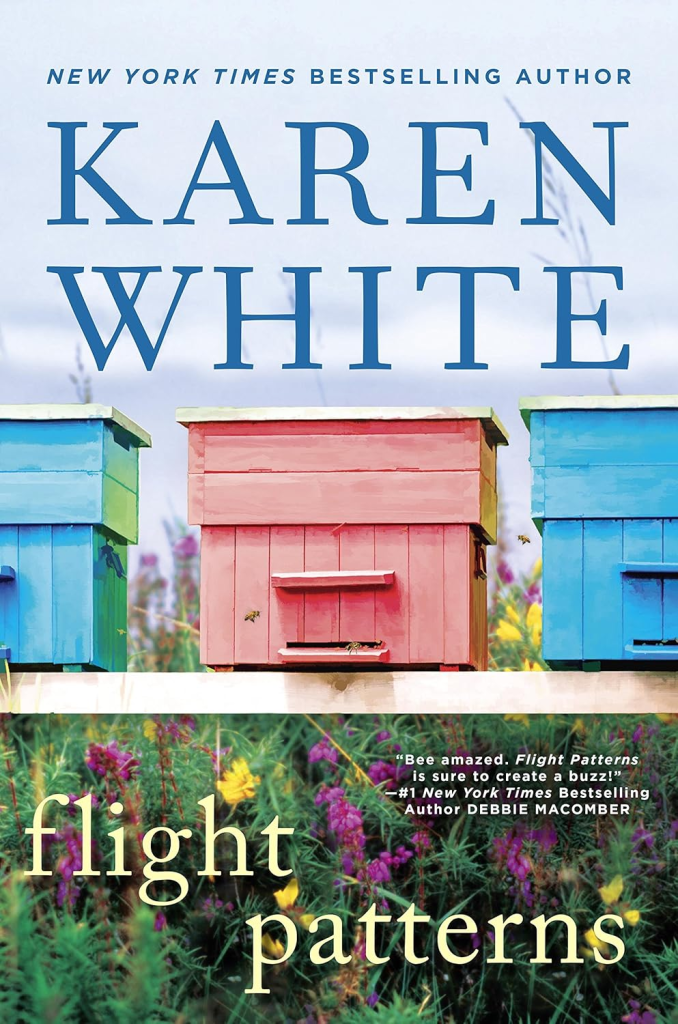Search the Blog
Categories
- Books & Reading
- Broadband Buzz
- Census
- Education & Training
- General
- Grants
- Information Resources
- Library Management
- Nebraska Center for the Book
- Nebraska Memories
- Now hiring @ your library
- Preservation
- Pretty Sweet Tech
- Programming
- Public Library Boards of Trustees
- Public Relations
- Talking Book & Braille Service (TBBS)
- Technology
- Uncategorized
- What's Up Doc / Govdocs
- Youth Services
Archives
Subscribe
Tag Archives: Reading
#BookFaceFriday “A Grim Reaper’s Guide to Catching a Killer” by Maxie Dara
This #BookFaceFriday is a graveyard smash!
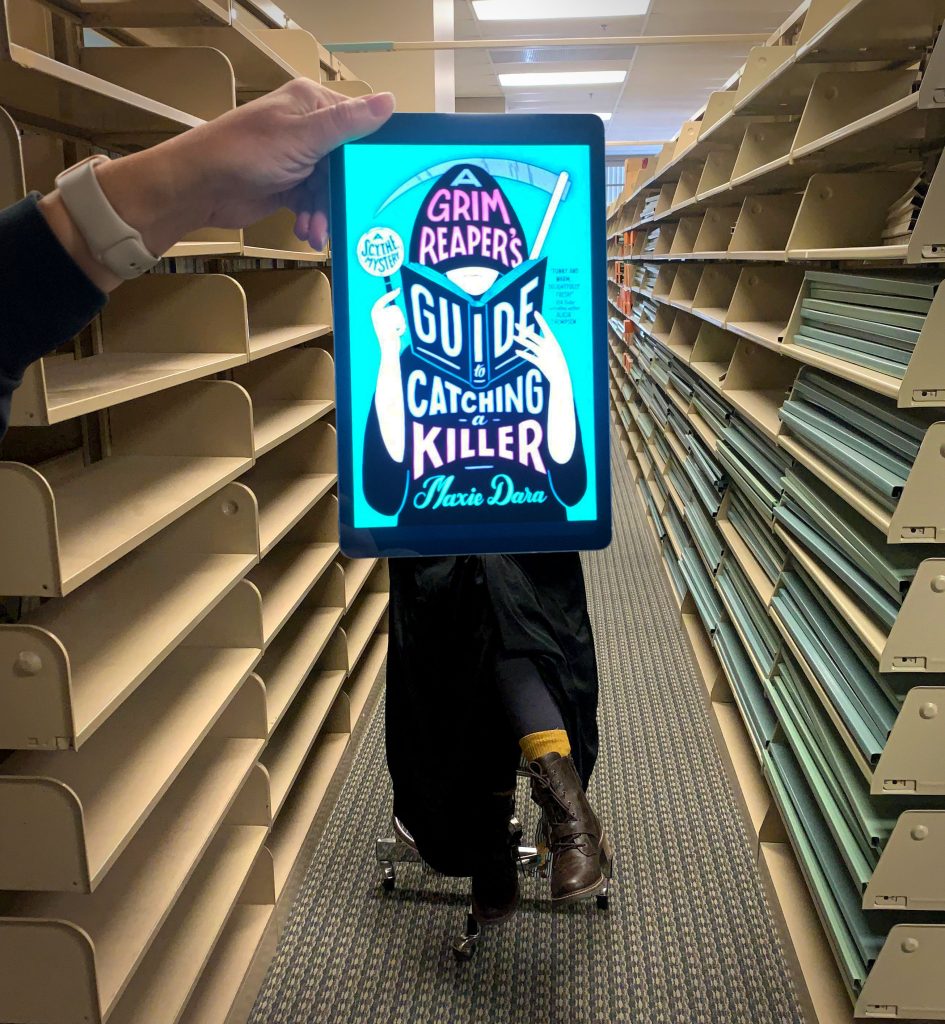
This week’s #BookFaceFriday is fully embracing spooky season! Join in with “A Grim Reaper’s Guide to Catching a Killer” by Maxie Dara (Berkley, 2024). This off-beat and humorous murder mystery is the first part in the author’s SCYTHE Mystery Series. It’s available as a an eBook and Audiobook through Nebraska OverDrive Libraries, and can be found in the specially curated collection “Monster Mash,” which is filled with Halloween, monster, or horror themed titles.
“Fun and lighthearted despite the presence of death, the characters are relatable and funny, and the paranormal aspects are balanced with the ordinariness of Kathy’s messy life. The ending fleshes out this creative premise and sets the book up for the next in a heartwarming series.”
— Booklist
Libraries participating in the Nebraska OverDrive Libraries Group currently have access to a shared and growing collection of digital downloadable audiobooks and eBooks. 194 libraries across the state share the Nebraska OverDrive collection of 26,898 audiobooks, 36,794 ebooks, and 5,133 magazines. As an added bonus it includes 130 podcasts that are always available with simultaneous use (SU), as well as SU ebooks and audiobook titles that publishers have made available for a limited time. If you’re a part of it, let your users know about this great title, and if you’re not a member yet, find more information about participating in Nebraska Overdrive Libraries!
Love this #BookFace & reading? We suggest checking out all the titles available for book clubs at http://nlc.nebraska.gov/ref/bookclub. Check out our past #BookFaceFriday photos on the Nebraska Library Commission’s Facebook page!
Book Club Spotlight – Conviction
It’s hard to ignore the impact that True Crime podcasts have had on pop culture. From movies to the TV Show Only Murders in the Building, and books like Listen for the Lie and A Good Girl’s Guide to Murder, we cannot get enough of the everyday person who gets swept up in the adrenaline of these dangerous stories. Gone are the days of the “Gentleman Detective” who solves crimes as a profession. The Amateur Detective is in it for the love of the game…and their lives! Today’s Spotlight Conviction by Denise Mina is no different. Here, her amateur detectives listen to True Crime podcasts to escape their lives but inextricably find themselves in the middle of the story- Murderers and all.
A woman with a false identity, and a disgraced famous musician race in the dead of night across the Scottish highlands. Just hours before, their respective partners had run off together, and now the two are on the case to solve a murder they heard about on a podcast. On their heels, the looming presence of someone far more powerful than they could ever imagine wants to see them silenced. 10 years ago, Leon Parker and his two adult children perished onboard as a famously haunted yacht sank under mysterious circumstances. The woman arrested for the crime could not have possibly committed it. Connecting this case to an unassuming housewife’s mysterious past, is the enigmatic and powerful Gretchen Teigler, who will stop at nothing to end anyone who dares get in her way.
“Just when you think something can’t get any worse, someone who dislikes you comes to watch.”
Denise Mina
A 2019 Reese’s Book Club Pick, Conviction is a great choice for those Book Club Groups looking for thrills and laughs this Halloween. Mina’s pacing and punchy characters keep you engaged and invested as the mystery of The Dana unravels. Washed-up Fin Cohen and suburban Anna McDonald, are not only trying to solve the case but make a podcast along the way, which ends up being as helpful as it is deadly. The chemistry between our mystery-solving duo is a true delight. Both come to the partnership with loads of baggage and they aren’t afraid to push each other’s buttons. Each of the copies in our collection comes with a Reading Group Guide in the back of the book including an interview with the author!
This book deals with the unfortunate reality of sexual violence and eating disorders which may be hard for some groups to discuss. For resources on how to talk to your community about these topics, I recommend these programs for education:
- National Eating Disorders Association
- The National Sexual Violence Resource Center
- The Rape, Abuse & Incest National Network
If you’re interested in requesting Conviction for your book club, you can find the Request Form here. There are 5 copies. (A librarian must request items)
Mina, Denise. Conviction. Mulholland Books. 2019.
Posted in Books & Reading
Tagged book club spotlight, books, Reading, Reese's Book Club
Leave a comment
#BookFaceFriday “Breaking Rank” by Kristin D. Randle
Don’t let this #BookFace strong arm you!

Are your younger readers looking for a great book? Let us lend you a (tiny) hand in finding the right title! The Library Commission has a large collection of book club kits for children and young adults. Like this week’s #BookFace ,”Breaking Rank” by Kristen D. Randle (Turtleback Books, 2001), perfect for readers ages 12 and up; it’s a part of our Book Club Kit collection, with thirteen copies available for checkout. Diving into themes of peer pressure and independent thinking, this novel has been compared to The Outsiders, West Side Story, and Romeo and Juliet.
“This novel challenges stereotypes and stigmas when an unprecedented friendship develops between two teens of rival high school groups. “Randle is adept at conveying ingrained prejudices as well as the frustration and alienation that leads some youths to forsake the `straight’ world for a more friendly and accepting one of their own making.”
—Publishers Weekly
Need a hand searching our collection? Here are some tips! You can browse our collection by genre or grade level, or use a keyword search to find Golden Sower nominees and winners. If you need a large number of books for a whole classroom, limit your search to only those sets with enough books to meet your needs. Still can’t find what you are looking for? Let us know and we’re happy to help.
Book Club Kits Rules for Use
- These kits can be checked out by the librarians of Nebraska libraries and media centers.
- Circulation times are flexible and will be based upon availability. There is no standard check-out time for book club kits.
- Please search the collection to select items you wish to borrow and use the REQUEST THIS KIT icon to borrow items.
- Contact the Information Desk at the Library Commission if you have any questions: by phone: 800/307-2665, or by email: Information Services Team
Love this #BookFace & reading? Check out our past #BookFaceFriday photos on the Nebraska Library Commission’s Facebook page!
Posted in Books & Reading, General, Youth Services
Tagged Banned Books Week, Book Club Kits, Book Covers, bookface, bookfacefriday, Breaking Rank, Kristin Randle, Novel, Reading, YA
Leave a comment
#BookFaceFriday “Healer & Witch” by Nancy Werlin
We’ll cast a spell on you with this #BookFaceFriday!
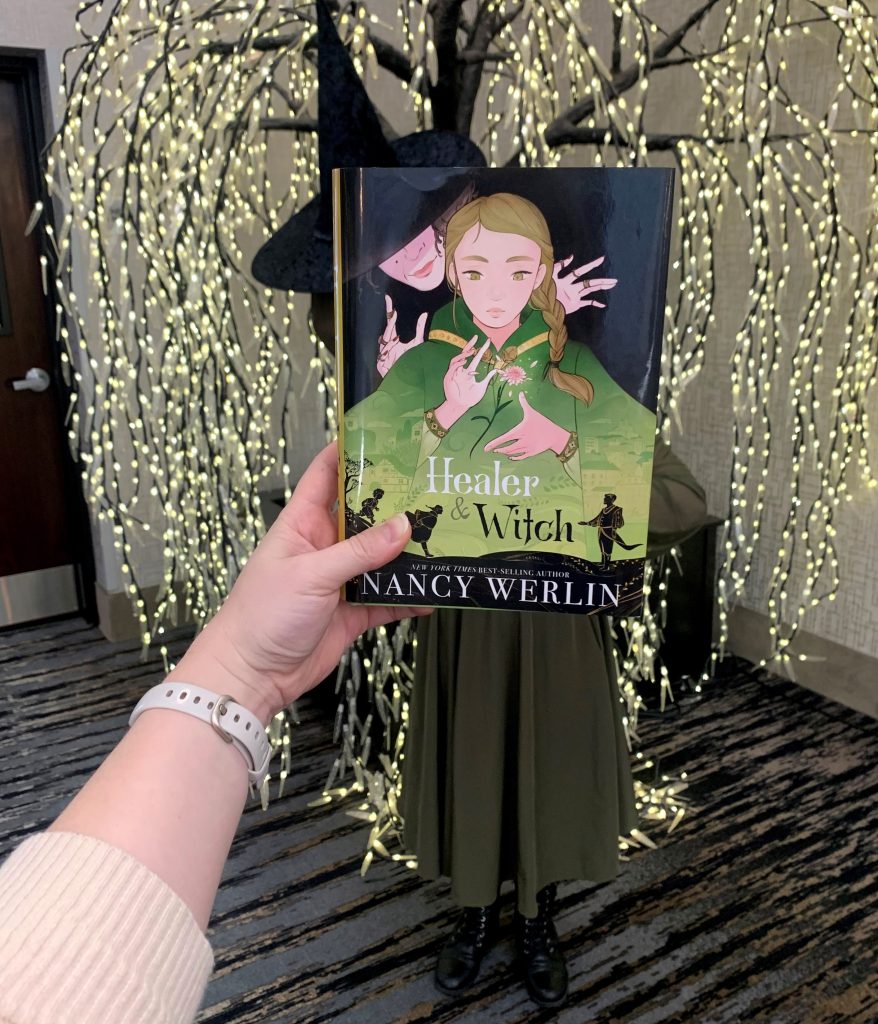
We’ve been at the Nebraska Library Association Conference this week connecting with Nebraska’s librarians and Library staff! Sally Snyder, NLC’s Children and Youth Services Coordinator, also had a table there full of her giveaway books, all available for libraries to take home with them. One of those books is this week’s #BookFace, “Healer & Witch” by Nancy Werlin (Candlewick Press, 2022). Perfect for middle grade readers, this coming-of-age YA novel is a fantasy and historical fiction story all rolled into one. All in all the perfect October read!
“Werlin’s first foray into middle grade is a thrilling and suspenseful experience; there are twisting reveals and adventure aplenty, though the story isn’t afraid to stop for lovely moments of
quiet contemplation and recollection along the way. A budding, respectful romance and hints of deeper powers will have readers hoping for a sequel. It’s well worth joining kind and clever Sylvie on her harrowing journey of discovery.”—Booklist (starred review)
This title comes from our large collection of children’s and young adult books sent to us as review copies from book publishers. When our Children and Young Adult Library Services Coordinator, Sally Snyder, is done with them, the review copies are available for the Library System Directors to distribute to school and public libraries in their systems.
Love this #BookFace & reading? Check out our past #BookFaceFriday photos on the Nebraska Library Commission’s Facebook page!
Posted in Books & Reading, General, Youth Services
Tagged Book Covers, bookface, bookfacefriday, Fantasy, Halloween, Healer & Witch, Historical Fiction, Nancy Werlin, Reading, YA books
Leave a comment
Book Club Spotlight – Bless Me, Ultima
To celebrate Hispanic Heritage Month, and Banned Books Week (September 22-28), today’s Book Club Spotlight covers both occasions! Bless Me, Ultima, by Rudolfo Anaya is considered a definitive American text by the National Endowment for the Arts, especially when representing the Chicano people, who embrace their Mexican identity culturally and politically in the United States. Winning the New Mexico Book Association Harris Award and the prestigious Premio Quinto Sol, Anaya, wrote from his life growing up in rural New Mexico for Bless Me, Ultima, highlighting and challenging predestination, prejudice, and the struggle to find where we belong.
Antonio Juan Márez y Luna is a perceptive six-year-old who feels as if he’s facing his destiny all too soon. His mother wants him to be a priest, his father wants him to be a farmer, and his brothers, now returned from the war, want him to take over their familial duties. But what does he want? Tony’s eyes are opened when the old curandera, Ultima, comes to live out the rest of her days with his family and takes him under her tutelage. From miraculous healings to finding gods in unassuming places, many paths now lay before him and he is torn between his burgeoning Catholic faith and the religion of the Earth. A young and tender boy with a lot of questions about the world, Tony learns from Ultima that there is so much more to his world hidden in the plains of the Vaqueros.
“The smallest bit of good can stand against all the powers of evil in the world and it will emerge triumphant.”
Rudolfo Anaya
Bless Me, Ultima is commonly taught in schools to middle-grade students and up. Exploring ideas of fate, right and wrong, and self-determination, Anaya’s novel is fit for anyone to discuss, making it a perfect choice for Book Club Groups of any age. Though its thoughtful discussions of religion, depictions of violence, and realistic language has led it to be the subject of book banning in the past. I encourage you to read PEN America’s incredible article arguing for the book, citing its impact and necessity as a fundamental educational text. To learn more about Bless Me, Ultima’s history of challenges, and how to implement the teaching into your group, visit its Book Resume courtesy of Penguin Random House.
If you’re interested in requesting Bless Me, Ultima for your book club, you can find the Request Form here. There are 12 copies. (A librarian must request items)
Anaya, Rudolfo. Bless Me, Ultima. TQS Publications. 1972.
Posted in Books & Reading
Tagged book club spotlight, books, Hispanic heritage month, Reading
Leave a comment
#BookFaceFriday “Unthinkable” by Helen Thomson
This #BookFace will blow your mind!
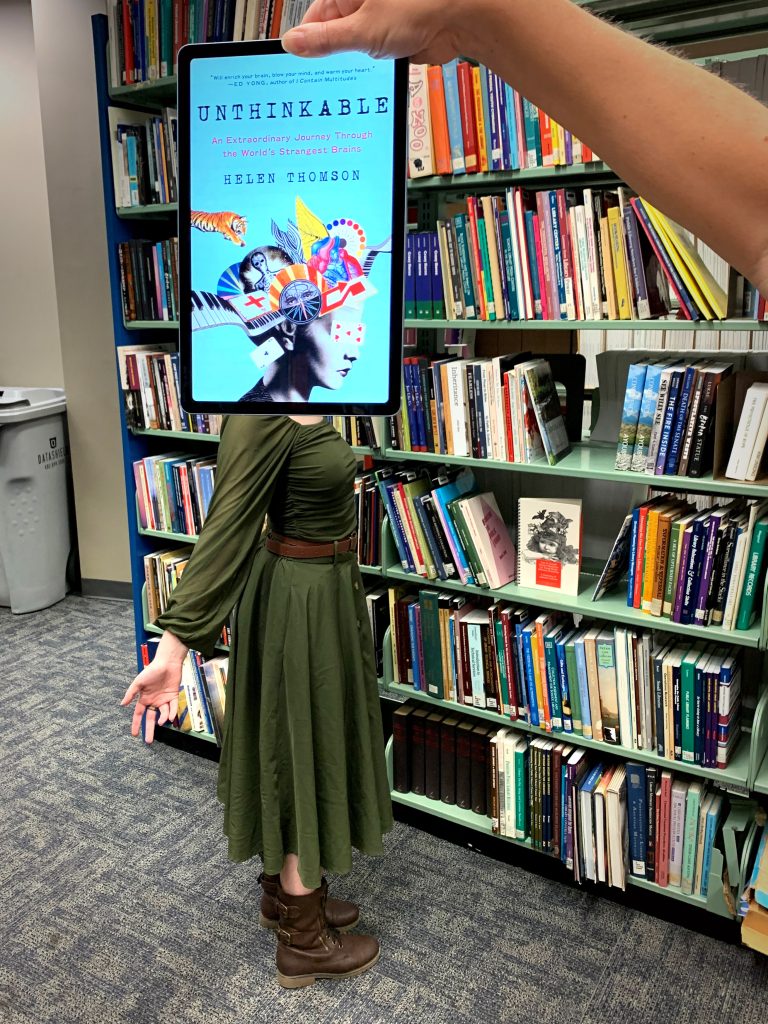
Free your mind, and the rest will follow. If you love learning through reading or just nonfiction books in general check out this week’s #BookFaceFriday, “Unthinkable” by Helen Thomson, it’s a nonfiction journey through some of the biggest mysteries of the human brain. You can find this title as an Audiobook through Nebraska OverDrive Libraries, it’s a part of the “Talk Nerdy to Me” curated collection in Overdrive.
“Thomson has a gift for making the complex and strange understandable and relatable. Oliver Sacks is noted as an inspiration and, indeed, this book will appeal to his many fans.”
—Library Journal (starred review)
Libraries participating in the Nebraska OverDrive Libraries Group currently have access to a shared and growing collection of digital downloadable audiobooks and eBooks. 194 libraries across the state share the Nebraska OverDrive collection of 26,898 audiobooks, 36,794 ebooks, and 5,133 magazines. As an added bonus it includes 130 podcasts that are always available with simultaneous use (SU), as well as SU ebooks and audiobook titles that publishers have made available for a limited time. If you’re a part of it, let your users know about this great title, and if you’re not a member yet, find more information about participating in Nebraska Overdrive Libraries
Love this #BookFace & reading? Check out our past #BookFaceFriday photos on the Nebraska Library Commission’s Facebook page!
Posted in Books & Reading, General
Tagged Book Covers, bookfacefriday, Helen Thomson, libraries, nonfiction, OverDrive, Reading, Unthinkable
Leave a comment
#BookFaceFriday “The Miseducation of Cameron Post” by Emily M. Danforth
This #BookFace is outstanding in its field!
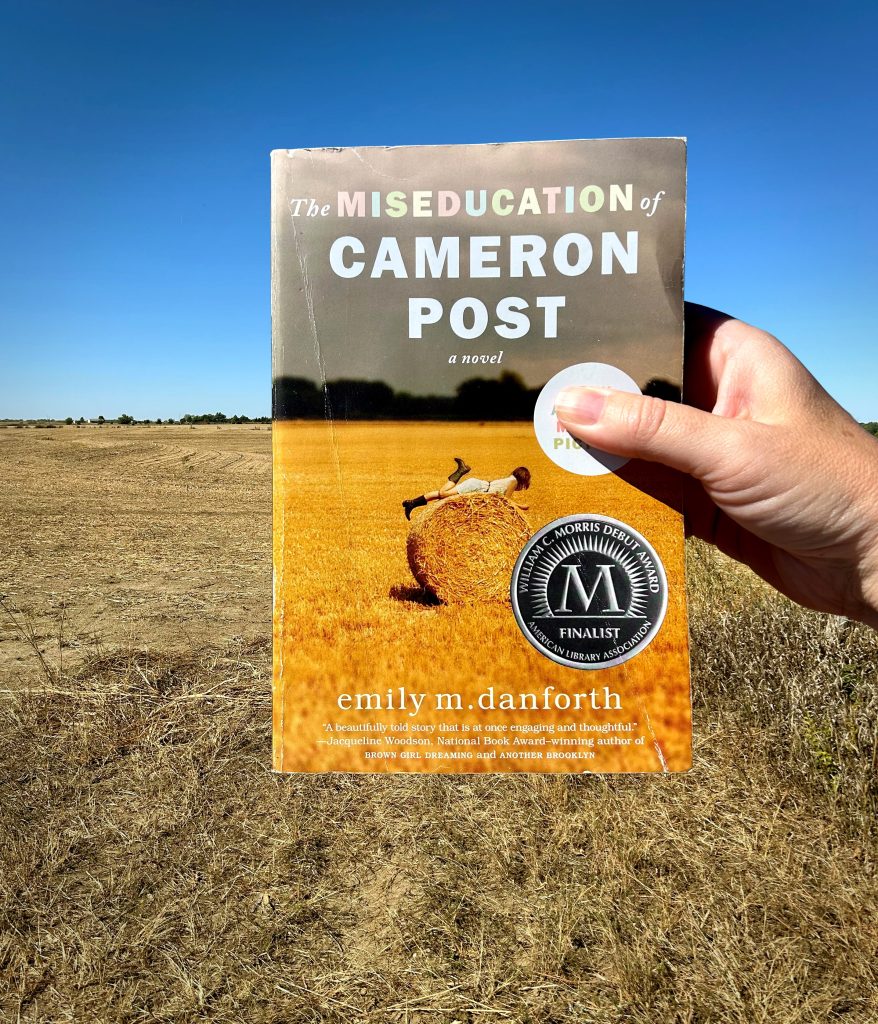
Freed between the lines! That’s the theme of this year’s #BannedBooksWeek. We are celebrating with a banned #BookFace! The Nebraska Library Commission supports readers and the freedom to read so we make sure our various collections reflect that. “The Miseducation of Cameron Post: A Novel” by Emily M. Danforth (Balzer + Bray, 2013) has been banned or challenged in the US since 2014, less than a year after it’s publication, cited for “inappropriate language, not appropriate for middle school age students.” It won The Montana Book Award and was a finalist for both the Morris Award and a Lambda Literary award. Emily Danforth was born in Montana and received her Ph.D in English-Creative Writing from the University of Nebraska-Lincoln! A book is considered challenged when calls are made for it to be banned or removed from the public’s access. This is one of many banned or challenged titles NLC has available in our Book Club Kit Collection, titles like The Perks of Being a Wallflower by Stephen Chbosky, Looking For Alaska by John Green, The Absolutely True Diary of a Part-Time Indian by Sherman Alexie, A Wrinkle in Time by Madeleine L’Engle, Beloved by Toni Morrison, and the Harry Potter Series by J.K. Rowling, just to name a few. This week’s #BookFace and other banned books can be found on the NLC Book Club Kit webpage. This service allows libraries and school librarians to “check out” multiple copies of a book without adding to their permanent collections, or budgets. NLC also has several banned or challenged titles available to our Nebraska OverDrive Libraries.
“This finely crafted, sophisticated coming-of-age debut novel is multilayered, finessing such issues as loss, first love, and friendship. An excellent read for both teens and adults.”
— School Library Journal (starred review)
You can find more information about Banned Books Week and the fight against censorship at ALA.org/advocacy/bbooks! What are you doing to celebrate Banned Books Week? Let us know!
Book Club Kits Rules for Use
- These kits can be checked out by the librarians of Nebraska libraries and media centers.
- Circulation times are flexible and will be based upon availability. There is no standard check-out time for book club kits.
- Please search the collection to select items you wish to borrow and use the REQUEST THIS KIT icon to borrow items.
- Contact the Information Desk at the Library Commission if you have any questions: by phone: 800/307-2665, or by email: Information Services Team
Love this #BookFace & reading? Check out our past #BookFaceFriday photos on the Nebraska Library Commission’s Facebook page!
Posted in Books & Reading, General
Tagged Banned Books Week, Book Club Kits, Book Covers, bookface, bookfacefriday, Lois Lowry, Reading, The Giver
Leave a comment
Book Club Spotlight – The Joy Luck Club
Amy Tan’s debut novel, The Joy Luck Club, drifts between the stories of mothers and daughters like the four winds of mahjong. Originally written as disconnected pieces, Tan evolved her work into a sweeping novel of generations, loss, and perseverance. Today’s Book Club Spotlight is extra special because the author is in Lincoln tonight! “A Conversation with Amy Tan” will be hosted at the Lied Center for Performing Arts for free with an accompanying live-stream at 7:30 pm. Her talk is a part of “The 29th Annual Governor’s Lecture in the Humanities”, hosted by Humanities Nebraska and the E.N. Thompson Forum on World Issues. Tickets and the live stream can be accessed, here: https://tickets.liedcenter.org/3342.
The Joy Luck Club, a group of Chinese immigrant women who gather for mahjong and community, grow their lives and families together in 1980s San Francisco. When matriarch Suyuan Woo passes away, her daughter Jing-mei is invited to take her mother’s spot at the table. And there she learns a hidden truth about her mother- she never stopped searching for the children she had to abandon in China decades ago, and only now have they been found. Jing-mei struggles with the loss of her mother, someone she feels as if she hardly knew, and the sudden reunification with her resurrected sisters. And in turn, like Suyuan, each daughter and mother of The Joy Luck Club, have kept themselves secret to their loved ones. Hiding difficult and life-defining events as an act of piety or restraint, that could ultimately grow and foster their fraught relationships.
“Then you must teach my daughter this same lesson. How to lose your innocence but not your hope. How to laugh forever.”
AMy Tan
The Joy Luck Club, while not an all-encompassing narrative of the Chinese Immigrant experience, shows four distinct paths taken. Suyuan Woo who fled from the war and left behind two children and her past. Lindo Jong, who escaped from a tyrannous marriage, believes in personal strength to her daughter’s detriment. An-mei Hsu, a passive player for most of her life, fears that she has bestowed those characteristics on her daughter. And Ying-ying St. Clair, a woman of means and wealth, is forced into poverty and silence, teaches her daughter to expect the same. All women with stories in equal measure, display their unresolved trauma to their daughters through words and actions, creating an endless cycle that must be broken. Tan’s work is essential to American literature (and media!), earning her the National Humanities Medal for “expanding the American literary canon. By bravely exploring experiences of immigrant families, heritage, memories, and poignant struggles”. Book Club Groups from High School to Adulthood can discuss her dissection of the immigrant experience, womanhood and perseverance, generational trauma, and what do we share with our loved ones?
If you’re interested in requesting The Joy Luck Club for your book club, you can find the Request Form here. There are 14 copies. (A librarian must request items)
Tan, Amy. The Joy Luck Club. Ballantine Books. 1989
#BookFaceFriday “Haven’s Wake” by Ladette Randolph & “Hell or High Water” by Joy Castro
When one #BookFace closes, another one opens.
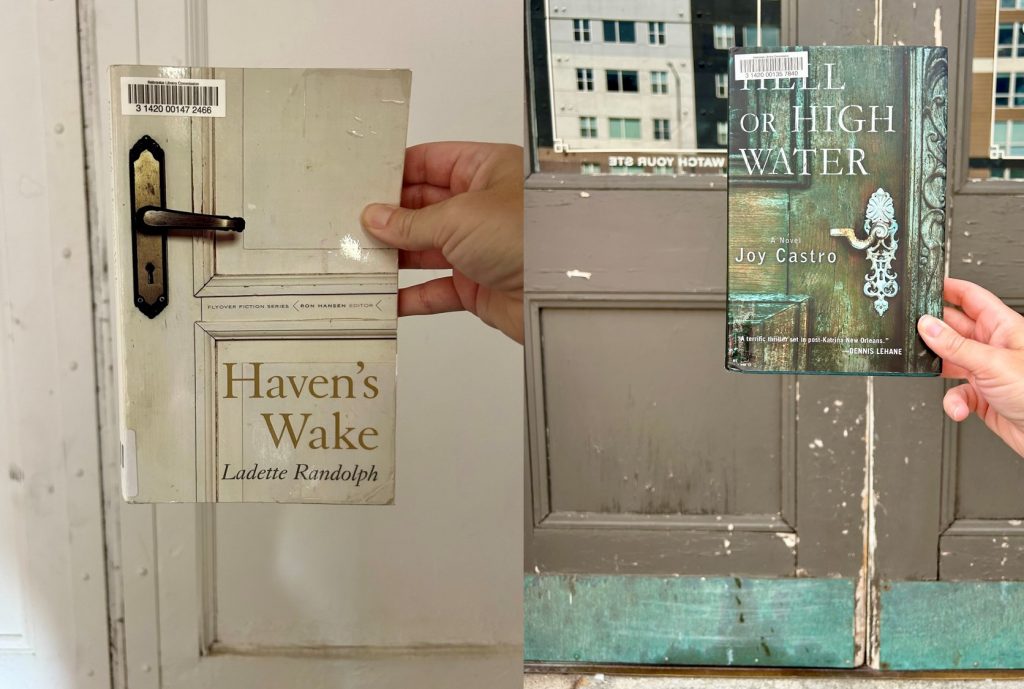
There’s nothing better than supporting Nebraska’s great literary talent by reading their books! This week’s #BookFaceFriday highlights two great Nebraska authors! “Haven’s Wake” by Ladette Randolph and “Hell or High Water” by Joy Castro, both novels are available as Book Club Kits for your library. Find more titles using the Nebraska-Related books located in the Browse Options section of our Book Club Kit Collection which includes fiction, nonfiction, adult, and kids/YA titles. Both “Haven’s Wake” and “Hell or High Water” can also be checked out through Nebraska OverDrive Libraries.
“With prose that vivifies the intricate patchwork of characters and captures the landscape’s simplicity, Haven’s Wake explores ‘the various attempts to explain the unexplainable,’ including family, faith, and death.”
—Katharine Fronk, Booklist Online
“A terrific mystery, but Hell or High Water is more than just a mystery; it’s a heartfelt examination of a second America–poor but undaunted–that was swept under the rug but refuses to stay there . . . I can’t wait to see what Joy Castro does next.”
– Dennis Lehane, New York Times bestselling author of Mystic River
Book Club Kits Rules for Use
- These kits can be checked out by the librarians of Nebraska libraries and media centers.
- Circulation times are flexible and will be based upon availability. There is no standard check-out time for book club kits.
- Please search the collection to select items you wish to borrow and use the REQUEST THIS KIT icon to borrow items.
- Contact the Information Desk at the Library Commission if you have any questions: by phone: 800/307-2665, or by email: Information Services Team
Libraries participating in the Nebraska OverDrive Libraries Group currently have access to a shared and growing collection of digital downloadable audiobooks and eBooks. 194 libraries across the state share the Nebraska OverDrive collection of 26,898 audiobooks, 36,794 ebooks, and 5,133 magazines. As an added bonus it includes 130 podcasts that are always available with simultaneous use (SU), as well as SU ebooks and audiobook titles that publishers have made available for a limited time. If you’re a part of it, let your users know about this great title, and if you’re not a member yet, find more information about participating in Nebraska Overdrive Libraries!
Love this #BookFace & reading? Check out our past #BookFaceFriday photos on the Nebraska Library Commission’s Facebook page!
#BookFaceFriday “The Underground Library” by Jennifer Ryan
Take a look, it’s in a #BookFaceFriday!

This week’s #BookFaceFriday is all about celebrating Library Card Sign Up Month! Join in with “The Underground Library: A Novel” by Jennifer Ryan (Ballantine Books, 2024). Libraries- More than Meets the Eye is this year’s theme. What can you do to help your community celebrate? Get out to your library, sign up for a library card, tell someone what you love about your library, and tell your local library staff how much you appreciate them! It’s that easy. This title is available as a an eBook and Audiobook through Nebraska OverDrive Libraries, and can be found in the specially curated collection “Library Card Sign Up Month,” which is filled with library themed titles.
“This uplifting and inspirational story is perfect for readers looking for heroic home front World War II novels with connections to actual events.”
— Historical Novel Society
Libraries participating in the Nebraska OverDrive Libraries Group currently have access to a shared and growing collection of digital downloadable audiobooks and eBooks. 194 libraries across the state share the Nebraska OverDrive collection of 26,898 audiobooks, 36,794 ebooks, and 5,133 magazines. As an added bonus it includes 130 podcasts that are always available with simultaneous use (SU), as well as SU ebooks and audiobook titles that publishers have made available for a limited time. If you’re a part of it, let your users know about this great title, and if you’re not a member yet, find more information about participating in Nebraska Overdrive Libraries!
Love this #BookFace & reading? We suggest checking out all the titles available for book clubs at http://nlc.nebraska.gov/ref/bookclub. Check out our past #BookFaceFriday photos on the Nebraska Library Commission’s Facebook page!
What’s Up Doc? New State Agency Publications at the Nebraska Library Commission
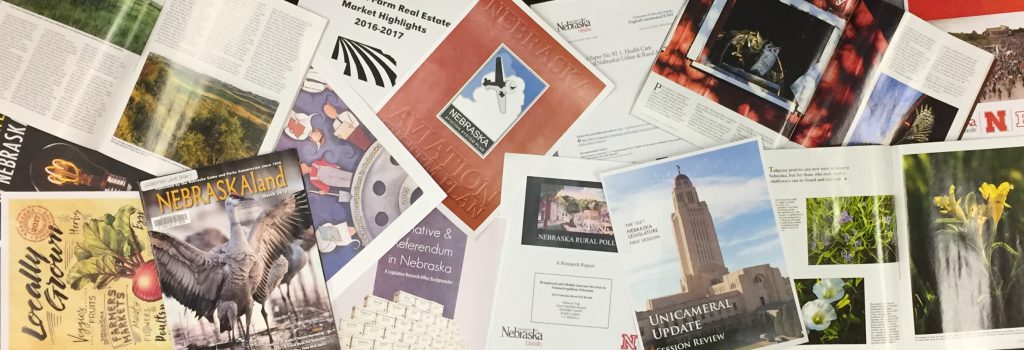
New state agency publications have been received at the Nebraska Library Commission for July and August, 2024. Included are Annual Reports from the Nebraska Department of Health and human Services, reports from the Nebraska Auditor of Public Accounts, the Nebraska State Treasurer, the Nebraska Department of Revenue, the Nebraska Department of Transportation, and the Nebraska Public Employees Retirement System, to name a few.
With the exception of University of Nebraska Press titles, items are available for immediate viewing and printing by clicking directly in the .pdf below.
The Nebraska Legislature created the Nebraska Publications Clearinghouse in 1972 as a service of the Nebraska Library Commission. Its purpose is to collect, preserve, and provide access to all public information published by Nebraska state agencies. By law (State Statutes 51-411 to 51-413) all Nebraska state agencies are required to submit their published documents to the Clearinghouse. For more information, visit the Nebraska Publications Clearinghouse page, contact Mary Sauers, Government Information Services Librarian; or contact Bonnie Henzel, State Documents Staff Assistant.
Posted in Books & Reading, Education & Training, General, Information Resources, What's Up Doc / Govdocs
Tagged books, GovDocs, Reading
Leave a comment
Book Club Spotlight – You Don’t Know Everything, Jilly P!
This month is National Deaf Awareness Month, which includes International Week of Deaf People from Sept 23rd through the 29th! Each day of the week is themed with ways to get involved and learn about the deaf community worldwide! Today’s Book Club Spotlight, You Don’t Know Everything Jilly P!, by Alex Gino, features a young girl learning about the Deaf community and beyond, when her sister is unexpectedly born Deaf. Best known for their debut novel, Melissa, Gino is a member of We Need Diverse Books and PEN America; two organizations with the mission to uplift marginalized voices and secure the right to read.
Jilly’s aunts say that after her baby sister is born, life will never go back to normal. And they’re right! When Emma is born Deaf, her parents aren’t prepared, but Jilly is way excited to tell her Deaf online friend Derek aka profoundinoaktown, the news. When his excitement doesn’t match hers, she’s confused and hurt. While her parents are busy meeting with audiologists, Jilly begins noticing her own differences and how they impact others. She’s hearing, so she doesn’t have to worry about communication and being left out of conversation. She’s also white and doesn’t have to worry about racism and violence like her Black friends and family do. Jilly’s aunt and her cousins are more than people who are Black, and Derek is more than someone who is Black and Deaf. They’re proud of their identities because each piece of them comes together to make who they are, but sometimes being who they are is unsafe. Jilly has a lot to learn, and even though she messes us up, she keeps trying. So when her sister is ready for the world, she will be too.
“The hard thing about accidentally saying the wrong thing is that you don’t know it’s the wrong thing until you’ve already said it and hurt someone. And even if you didn’t mean it that way, you can’t take it back.”
Alex Gino
For 3rd-grade readers and up, You Don’t Know Everything, Jilly P, takes on aspects of Gino’s real-life experience of having Deaf and Black family and friends and learning how their life experiences and opportunities differ. In traditional Alex Gino fashion, the book handles some pretty intense topics with care and compassion, from learning and respecting Deaf culture, to spotting racist microaggressions and talking to others about racism. In the author’s note, Gino states that “books and stories are tools for talking about contemporary issues and that young readers need and deserve these tools just as much as the rest of us”. When it comes to discussing these topics with your students or a Book Club Group, don’t fear- the Scholastic Discussion Guide not only includes great questions for readers of all ages- but further resources into Deaf Culture, ASL, Civil Rights, and how to act as an ally, not just a bystander, in your community.
Interview with Alex Gino by Deaf writer Ann Clare Le Zotte:
If you’re interested in requesting You Don’t Know Everything, Jilly P! for your book club, you can find the Request Form here. There are 22 copies. (A librarian must request items)
Gino, Alex. You Don’t Know Everything, Jilly P!. Scholastic. 2019
Posted in Books & Reading
Tagged book club spotlight, books, Deaf awareness month, Reading
Leave a comment
Friday Reads : Flight Patterns, by Karen White
I recently picked up Flight Patterns, by Karen White, at a library book sale. And while the author was new to me, what really drew my attention was not just the description of the story, but of the story’s location: Apalachicola, Florida. Apalach, as it’s known to it’s residents, is a town not far from where I grew up and that offers some of the most beautiful homes, gorgeous beaches, and best seafood in the entire South. Flight Patterns tells the story of a woman coming home to the Apalach family she left behind – and to the woman she always wanted to be. In the telling of this woman’s story, Ms. White has done such a magnificent job of describing the beauty of the town, area and people, that it brought back many fond memories of summer days there with my family. As per my usual habit, I both read and listened to this title, and was riveted from beginning to end, as I’m sure you will be too!
Georgia Chambers has spent her life sifting through other people’s pasts while trying to forget her own. But then her work as an expert on fine china – especially Limoges and the mystery surrounding a particular pattern – requires her to return to the one place she swore she’d never revisit: her home town.
It’s been 13 years since Georgia left her family home on the coast of Florida, and nothing much has changed except that there are fewer oysters and more tourists. She finds solace in seeing her grandfather still toiling away with his bees in the apiary where she spent much of her childhood, but encountering her estranged mother and sister leaves her rattled. Seeing them after all this time makes Georgia realize that something has been missing – and unless she finds a way to heal these rifts, she will forever be living vicariously through other people’s remnants. To embrace her own life – mistakes and all – she will have to find the courage to confront the ghosts of her past and the secrets she was forced to keep. **Synopsis courtesy of Audible
#BookFaceFriday “The Book of Unknown Americans” by Cristina Henríquez
Did you know it’s #BookFaceFriday?

Don’t blame us for judging a book by its cover – this one was just asking to become this week’s #BookFace! But sometimes those first impressions prove to be correct; “The Book of Unknown Americans” by Cristina Henríquez, was “named a New York Times and Washington Post Notable Book, an NPR Great Read, The Daily Beast’s Novel of the Year, and a Mother Jones, Oprah.com, School Library Journal, and BookPage Best Book of the Year.” This title is available as a part of our Book Club Kit collection, and also as an eBook and Audiobook through Nebraska OverDrive Libraries. Will your book club enjoy it? Only one way to know for sure…
“There’s an aura of benevolence in these pages…. Henríquez’s feat is to make the reader feel at home amid these good, likable people.”
—The Wall Street Journal
“Unfailingly well written and entertaining…. [Henríquez’s] stories illuminate the lives behind the current debates about Latino immigration.”
– The New York Times Book Review
Book Club Kits Rules for Use
- These kits can be checked out by the librarians of Nebraska libraries and media centers.
- Circulation times are flexible and will be based upon availability. There is no standard check-out time for book club kits.
- Please search the collection to select items you wish to borrow and use the REQUEST THIS KIT icon to borrow items.
- Contact the Information Desk at the Library Commission if you have any questions: by phone: 800/307-2665, or by email: Information Services Team
Libraries participating in the Nebraska OverDrive Libraries Group currently have access to a shared and growing collection of digital downloadable audiobooks and eBooks. 194 libraries across the state share the Nebraska OverDrive collection of 26,898 audiobooks, 36,794 ebooks, and 5,133 magazines. As an added bonus it includes 130 podcasts that are always available with simultaneous use (SU), as well as SU ebooks and audiobook titles that publishers have made available for a limited time. If you’re a part of it, let your users know about this great title, and if you’re not a member yet, find more information about participating in Nebraska Overdrive Libraries!
Love this #BookFace & reading? Check out our past #BookFaceFriday photos on the Nebraska Library Commission’s Facebook page!
Book Club Spotlight – The Invisible Man
A man of many passions, from music, art, to class consciousness, and social theory, Ralph Waldo Ellison (named after the leader of the Transcendentalist movement), is best known for his contributions to the American literary canon. His sharp satirical works and his contemporary exploration of the varied lives of African Americans pre-Civil Rights earned his place as the first African-American to win the National Book Award for Fiction for his 1952 novel, Invisible Man.
When we meet our narrator, the eponymous Invisible Man, he is living in an abandoned basement of a whites-only apartment in New York City. He reassures us that this is no hovel, as it glows with a thousand lights of promise (and siphoned electricity). Before he was in this shelter, he lived a life full of promise. As a young man, his academic prowess awarded him a chance to speak in front of the town’s white elites. But instead of a simple speech, he is forced into a blinded battle royale with other Black youth; and only once he is debased and beaten bloodless is he allowed to speak. As his life’s journey takes him from his home in the south to New York City, he is struck by how this promised land holds the same prejudices and obstacles to self-actualization. As a disillusioned young man stuck in the perpetual cycle of fighting for liberation, he must put on a respectable front to exist in a world that is systemically works against him.
“I was pulled this way and that for longer than I can remember. And my problem was that I always tried to go in everyone’s way but my own. I have also been called one thing and then another while no one really wished to hear what I called myself.”
― Ralph Ellison
Not to be confused with the science fiction book of the same name- the invisibility in Ellison’s Invisible Man, is theoretical and social, rather than a physical condition. His unnamed narrator, a bright young Black man in the Jim Crow South, has a promising future that depends on him making himself inoffensive, and inconsequential to the white men who hold power over him. It’s also important to remember that these Black men who had to be “invisible” to the white society, were absolutely not invisible to the women and children in their lives. As we discussed in The Bluest Eye, Pecola Breedlove’s situation is informed by those around her and their treatment by society. Invisible Man was a large influence on Morrison’s work- acting as a conversation point to where she would take those deemed “invisible” and show them in the light that their contemporaries would have seen them. Here, her perspective is just as valuable as Ellison’s.
Invisible Man, while an important piece of American literature, is not an easy read. Taught in AP Literature courses and College-Level Classes, this book demands dissection and close reading. When working with your class, or dedicated Book Club Group, I highly recommend taking advantage of the Cliffs Notes. (Did you know that the founder, Clifton Hillegass, was a lifelong Nebraskan?) Study tools, like Cliffs Notes, are a great accessible tool for modern readers who might lack context for classic literature, and content thoughtful analysis that assists, not hinder the reading experience.
If you’re interested in requesting Invisible Man for your book club, you can find the Request Form here. There are 10 copies. (A librarian must request items)
Ellison, Ralph. Invisible Man. Random House. 1952
#BookFaceFriday “The White House: A Meet the Nation’s Capital Book” by Lindsay Ward
This #BookFaceFriday is in Washington D.C.!
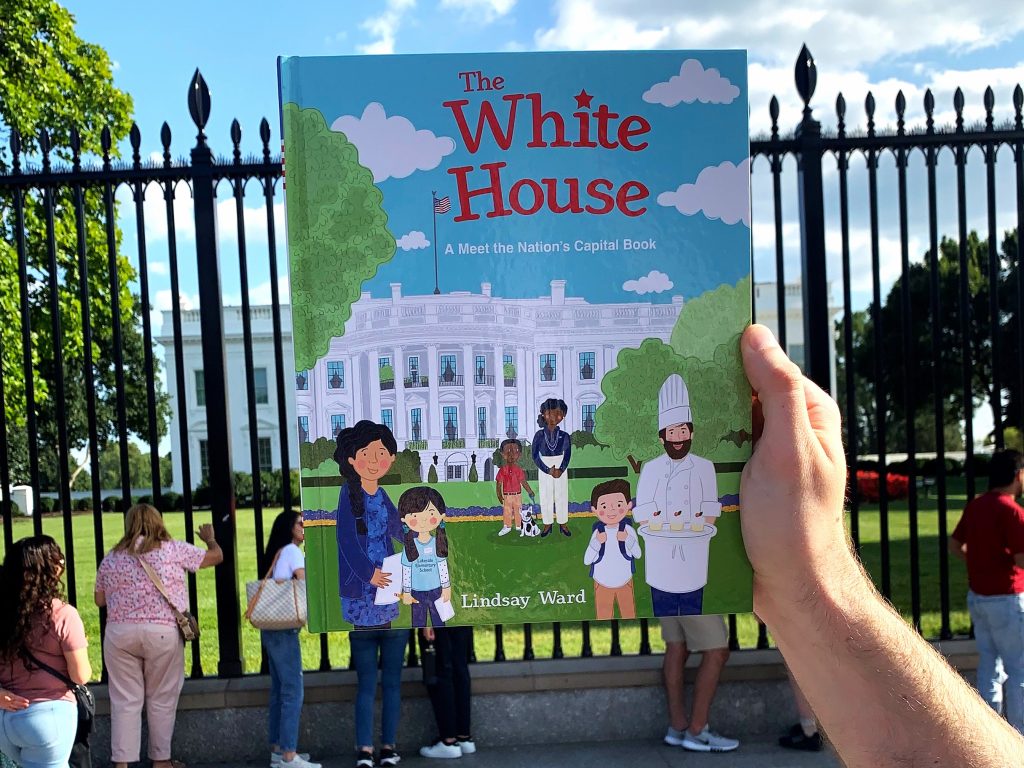
There’s so much to learn in this week’s #BookFace! “The White House: A Meet the Nation’s Capital Book” by Lindsay Ward (HarperCollins, August 2024) is a fun, interactive picture book that’s perfect for educating kids on the inner workings and different people who work inside of the White House.
“An expansive reminder that our government is of, as well as by and for, the people.” —Kirkus Reviews
We couldn’t resist bringing this week’s bookface with us to the National Book Festival in Washington, D.C.! The Nebraska Center for the Book has selected one youth book and one adult book by Nebraska authors to represent the state at the 2024 National Book Festival: “Eat Your Woolly Mammoths!: Two Million Years of the World’s Most Amazing Food Facts, from the Stone Age to the Future” by James Solheim and “Dancing with the Octopus: A Memoir of a Crime” by Debora Harding. Both titles will be part of the National Center for the Book’s Great Reads from Great Places program. Check out the festival schedule, featured authors, and highlights for past events on the Library of Congress’s event page!
This title comes from our large collection of children’s and young adult books sent to us as review copies from book publishers. When our Children and Young Adult Library Services Coordinator, Sally Snyder, is done with them, the review copies are available for the Library System Directors to distribute to school and public libraries in their systems.
Love this #BookFace & reading? Check out our past #BookFaceFriday photos on the Nebraska Library Commission’s Facebook page!
Friday Reads – The Mona Lisa Vanishes by Nicholas Day
Did you ever wonder why the Mona Lisa is so famous? Surely it’s because Leonardo Da Vinci was such a talented artist. Or perhaps the actual Mona Lisa was so beautiful and beloved that artists clamored to paint her portrait? Or… perhaps the painting gained its stature as one of the most recognizable pieces of art worldwide because of a little incident that took place 113 years ago this week, on August 21, 1911. A mysterious man in a white smock hid inside a closet at the Lourve until the museum was closed, and when the coast was clear, he took the Mona Lisa off its wall, removed its frame, and walked out the door.
And thus begins Nicholas Day’s “The Mona Lisa Vanishes: a Legendary Painter, a Shocking Heist, and the Birth of a Global Celebrity.” Curious to find out more? I certainly was!
Day weaves a compelling tale of how lax security at the Lourve and a bungled police investigation led to an international fascination with a small painting most of the world had never seen. Intertwined with the intrigue of the art heist is the rather absurd life story of Da Vinci himself and how he came to paint the Mona Lisa – one of the few endeavors he seems to have carried out to completion. Brilliant but easily distracted, Leonardo Da Vinci was famous for his flakiness as much as his talent.
Aimed at middle-grade readers, this fast-paced work of narrative nonfiction should hold the attention of mystery-lovers of all ages. Fans of the “A Series of Unfortunate Events” books by Lemony Snicket may recognize the illustrations of Brett Helquist throughout.
Day, Nicholas. (2023). The Mona Lisa Vanishes. Random House Studio.
Posted in Books & Reading, General
Tagged art history, art theft, books, Da Vinci, Friday Reads, middle grade, Mona Lisa, narrative nonfiction, Reading, True Crime
Leave a comment
#BookFaceFriday “Murder on a School Night” by Kate Weston
We did our homework- it’s #BookFaceFriday!
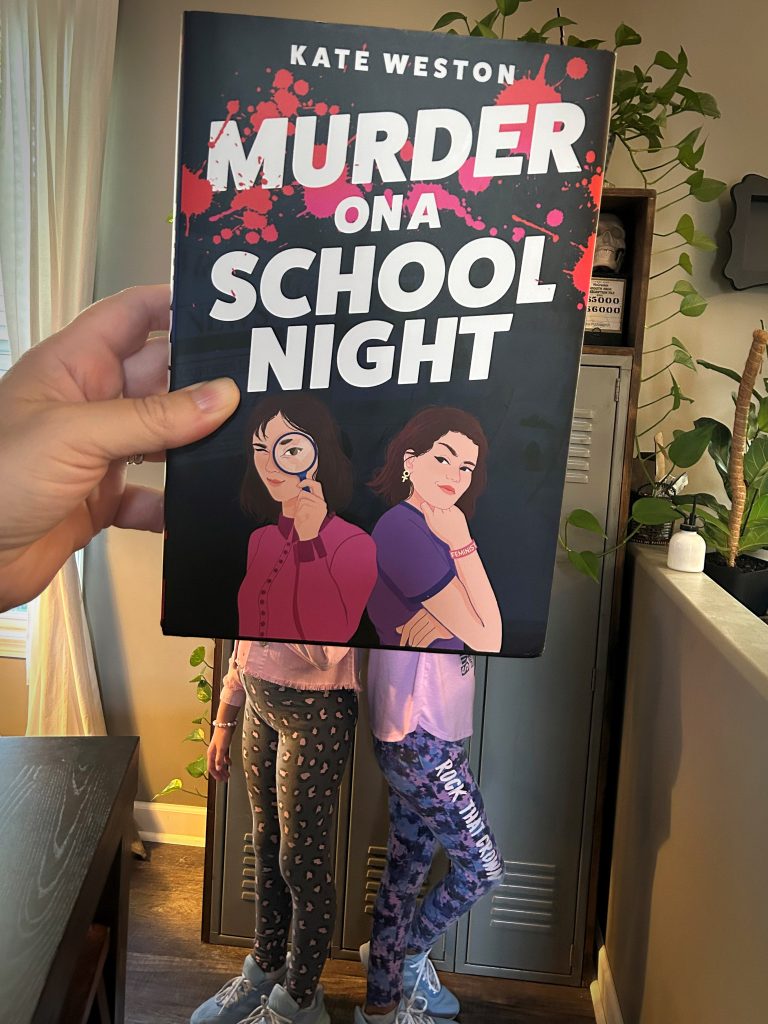
Don’t let the first few week’s of school push you over the edge! Back to school can be stressful, but finding great books for your kids to read doesn’t have to be. Whether its through our Book Club Kits collection, eBooks and Audiobooks in Nebraska OverDrive Library, picking up a title from our giveaway books. there is something for everyone in at all reading levels. Like this week’s #BookFace! “Murder on a School Night” by Kate Weston (Katherine Tegen Books, 2023) this funny, witty murder mystery for teens is written by a former stand up comedian and bookseller.
“Mean Girls meets Midsomer Murders with a dash of Louise Rennison in this genre-blending story that centers girls’ friendships and two ambitious best friends. Kerry and Annie are self-absorbed friends whose obsession over their lack of popularity results in hysterically funny dialogue and a lighthearted tone. Kerry’s crush on newcomer Scott offers sweet diversions. However, what really elevates the goofy capers and over-the-top scheming is how well Kerry and Annie know both themselves and each other. Secrets add depth and complexity to this insightful parody of teenage life. A nuanced, hilarious page-turning romantic mystery.” —Kirkus Reviews
This title comes from our large collection of children’s and young adult books sent to us as review copies from book publishers. When our Children and Young Adult Library Services Coordinator, Sally Snyder, is done with them, the review copies are available for the Library System Directors to distribute to school and public libraries in their systems.
Love this #BookFace & reading? Check out our past #BookFaceFriday photos on the Nebraska Library Commission’s Facebook page!
Posted in Books & Reading, General, Youth Services
Tagged back to school, Book Covers, bookface, bookfacefriday, Kate Weston, Murder on a School Night, Reading
Leave a comment
Book Club Spotlight- The Bluest Eye
It’s no secret that here at the Book Club Spotlight, we adore Toni Morrison. After visiting her novel Sula two years ago- we’re back and reading her debut novel The Bluest Eye. Before her writing career, Morrison was a senior editor at Random House and amplified Black authors, like the incomparable Angela Davis during her tenure. The first Black woman recipient of the Nobel Prize in Literature, Morrison’s lyrical novels explore what it is like physically and emotionally to exist in a world that does its best to harm you through race, gender, and class. The Bluest Eye was born out of her need to express the realities of racism and its effects on the most vulnerable- young Black girls.
The marigolds must grow, and Pecola Breedlove is pregnant. The marigolds must grow, and eleven-year-old Pecola Breedlove is pregnant by her father. The marigolds never came, and Pecola Breedlove’s baby has died. Before the marigolds, and before her baby dies, Pecola yearns for one thing more than anything else in the world. To have beautiful blue eyes. To have beautiful blue eyes to keep her safe from the world. Eyes as blue as the blonde-haired baby doll that Claudia MacTeer despises. Claudia MacTeer despises the blue-eyed, blond-haired baby doll because others say she must love it. And she has not yet learned to hate her eyes. Who taught Pecola Breedlove to?
“Certain seeds it will not nurture, certain fruit it will not bear and when the land kills of its own volition, we acquiesce and say the victim had no right to live”
Toni Morrison
The Bluest Eye is a harrowing journey of young Pecola Breedlove as the systems and people around her fail time and time again. It is a story long taught in literature classes around the country to educate readers on empathy, internalized racism, the importance of community, and the consequences of unchecked hatred and abuse towards the other as perpetuated by the “Master Narrative”. Like most of Morrison’s novels, The Bluest Eye can be read in an afternoon on one’s own. However, the subject matter and encouragement to dig deep into one’s internal predilections and biases let it thrive under discussions by literary-focused classrooms and Book Club Groups. In the Afterword (included in all of our copies), Morrison discusses how the intimate and cruel nature of the story is critical to sharing these taboo “cultural secrets”, and to put the story in the hands of the victims was a radical act of release and exposure.
“I wanted the narrator’s presence of voice to take the hand of the reader to say “You know this is going to be terrible, but don’t worry it’s already happened. I have been there and we can get through it together and it’s going to be fine.
- Toni Morrison on difficult narratives in an 1988 Interview with Mavis Nicholson
With its dark, yet revealing subject matter, it is no surprise that The Bluest Eye has long been a victim of book banning, and was the 7th most challenged book of 2023. For resources on how to fight book bans and prepare for 2024’s Banned Books Week (Sept 22-28), visit BannedBooksWeek.org.
If you’re interested in requesting The Bluest Eye for your book club, you can find the Request Form here. There are 15 copies. (A librarian must request items)
Morrison, Tony. The Bluest Eye. Vintage Books. 1970
#BookFaceFriday “Proud” by Ibtihaj Muhammad
En guard! It’s #BookFaceFriday!
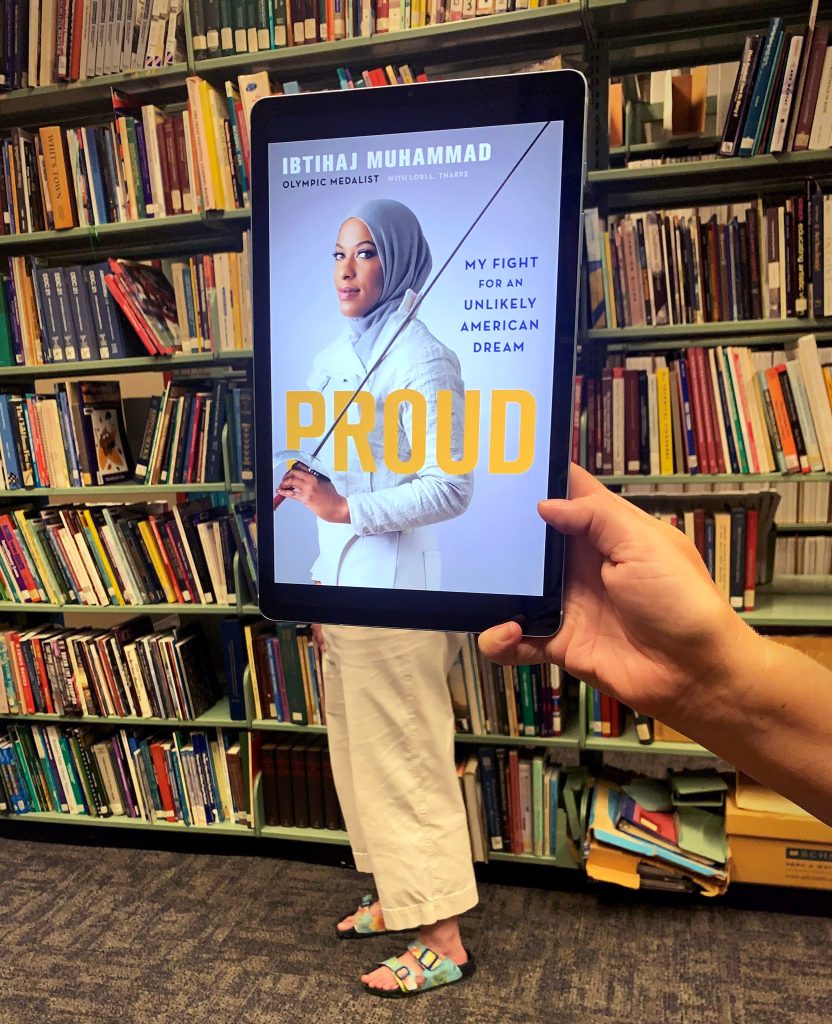
On the fence about what to read this weekend? Why not check out one of the many titles about the Olympic Games and athletes available on Overdrive. This week’s #BookFace, “Proud: My Fight for an Unlikely American Dream” by Ibtihaj Muhammad with Lori Tharps, is the memoir of Olympic bronze medalist and Muslim American, Ibtihaj Muhammad. You can find this title as an Audiobook through Nebraska OverDrive Libraries, as well as her Young Readers Edition “Proud: Living My American Dream” which is available as both an eBook and Audiobook.
“Fencing made her who she is today, but fencing isn’t her only narrative. Her journey is one of authenticity at all costs and being unapologetically herself.”
—ESPNw
Libraries participating in the Nebraska OverDrive Libraries Group currently have access to a shared and growing collection of digital downloadable audiobooks and eBooks. 194 libraries across the state share the Nebraska OverDrive collection of 26,898 audiobooks, 36,794 ebooks, and 5,133 magazines. As an added bonus it includes 130 podcasts that are always available with simultaneous use (SU), as well as SU ebooks and audiobook titles that publishers have made available for a limited time. If you’re a part of it, let your users know about this great title, and if you’re not a member yet, find more information about participating in Nebraska Overdrive Libraries
Love this #BookFace & reading? Check out our past #BookFaceFriday photos on the Nebraska Library Commission’s Facebook page!




